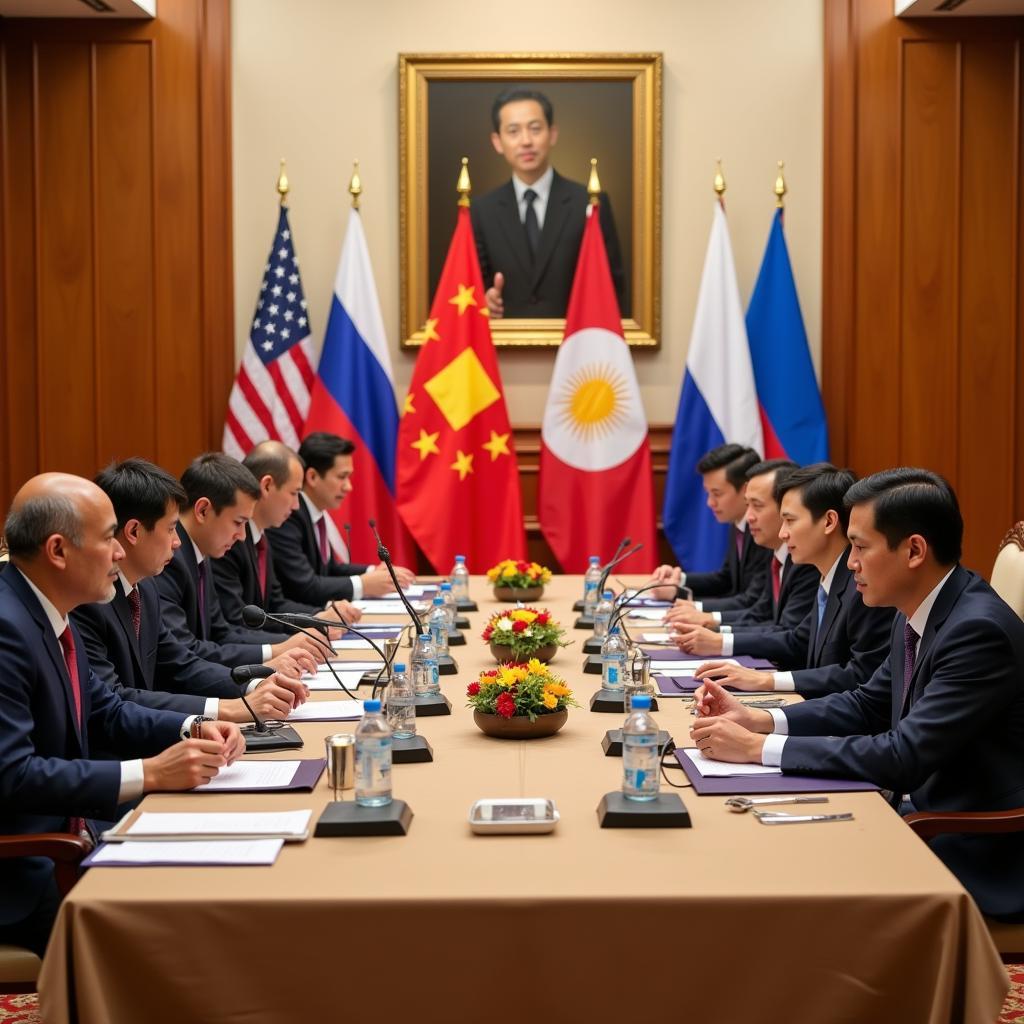ASEAN Plus Six, a key forum for dialogue and cooperation in East Asia, brings together the ten ASEAN member states and six crucial dialogue partners: China, Japan, South Korea, India, Australia, and New Zealand. This expanded partnership aims to tackle shared regional challenges and foster greater economic integration beyond the core ASEAN bloc.
Delving into the ASEAN Plus Six Framework: Who Are the “Anggota ASEAN Plus Six”?
The term “Anggota Asean Plus Six” translates to “members of ASEAN Plus Six” in Indonesian. This group plays a significant role in shaping regional dynamics and promoting peace, stability, and prosperity in East Asia. It’s essential to understand not only who these members are but also the motivations and complexities that drive their collaborations within this framework.
ASEAN’s Core Ten: The Foundation of ASEAN Plus Six
The Association of Southeast Asian Nations (ASEAN) forms the bedrock of the Plus Six mechanism. These ten nations, Brunei Darussalam, Cambodia, Indonesia, Laos, Malaysia, Myanmar, the Philippines, Singapore, Thailand, and Vietnam, represent a diverse tapestry of cultures, economies, and political systems. Their shared commitment to regional cooperation paved the way for the inclusion of the Plus Six dialogue partners.
The Plus Six Partners: Expanding the Circle of Cooperation
The six dialogue partners, China, Japan, South Korea, India, Australia, and New Zealand, each bring unique strengths and perspectives to the table. China and Japan, as major economic powerhouses, contribute significantly to regional trade and investment. South Korea’s technological prowess and India’s burgeoning market offer further opportunities for collaboration. Australia and New Zealand, with their advanced economies and strong democratic traditions, contribute to the stability and balance of the partnership.
Key Objectives of ASEAN Plus Six Cooperation
ASEAN Plus Six prioritizes cooperation in various sectors, including economic development, trade facilitation, financial stability, energy security, environmental protection, and disaster management. By working together, these sixteen nations aim to address complex challenges that transcend national borders and require collective action.
Why is ASEAN Plus Six Important?
ASEAN Plus Six provides a platform for constructive dialogue and practical cooperation on critical issues impacting the region. This framework complements existing ASEAN mechanisms and strengthens the overall architecture for regional cooperation.
Promoting Economic Integration
One of the primary goals of ASEAN Plus Six is to enhance economic integration and promote sustainable growth within East Asia. Through regular consultations and joint initiatives, member countries strive to create a more conducive environment for trade and investment.
Addressing Regional Challenges
ASEAN Plus Six plays a crucial role in addressing shared challenges such as climate change, transnational crime, and pandemics. By pooling resources and expertise, these nations can respond more effectively to these complex issues.
 ASEAN Plus Six Summit Meeting
ASEAN Plus Six Summit Meeting
Fostering Peace and Stability
By fostering dialogue and building trust among its members, ASEAN Plus Six contributes to maintaining peace and stability in the region. This open communication channel allows for the peaceful resolution of disputes and promotes a shared understanding of regional security concerns.
“The ASEAN Plus Six mechanism is not merely about expanding membership, but about deepening engagement and addressing critical challenges collectively,” notes Dr. Amelia Tan, a prominent Southeast Asian political analyst. “This framework provides a valuable platform for building bridges and fostering a more integrated and prosperous East Asian community.”
Conclusion: The Future of ASEAN Plus Six
ASEAN Plus Six represents a vital framework for regional cooperation in East Asia. By bringing together the ten ASEAN nations and six key dialogue partners, this mechanism promotes economic integration, addresses shared challenges, and fosters peace and stability. Understanding the “Anggota ASEAN Plus Six,” their motivations, and the complexities of their interactions is essential for navigating the evolving landscape of East Asian regionalism.
“The future of regional stability hinges on the success of frameworks like ASEAN Plus Six,” adds Professor Kenji Sato, an expert in international relations at Kyoto University. “Its ability to adapt to emerging challenges and foster deeper cooperation will be key to its long-term effectiveness.”
FAQ
-
What does “Anggota ASEAN Plus Six” mean?
- It means “members of ASEAN Plus Six” in Indonesian.
-
Who are the Plus Six countries?
- China, Japan, South Korea, India, Australia, and New Zealand.
-
What are the main objectives of ASEAN Plus Six?
- Promoting economic integration, addressing regional challenges, and fostering peace and stability.
-
Why is ASEAN Plus Six important?
- It provides a platform for dialogue and cooperation on critical issues impacting the region.
-
How does ASEAN Plus Six complement ASEAN?
- It strengthens the overall architecture for regional cooperation in East Asia.
-
What are some examples of cooperation within ASEAN Plus Six?
- Joint initiatives on trade facilitation, financial stability, and disaster management.
-
What is the future of ASEAN Plus Six?
- Its continued success depends on its ability to adapt to emerging challenges and deepen cooperation.
For further assistance, please contact us at Phone Number: 0369020373, Email: aseanmediadirectory@gmail.com or visit our office at Ngoc Lien Village, Hiep Hoa, Bac Giang, Vietnam. We have a 24/7 customer service team.